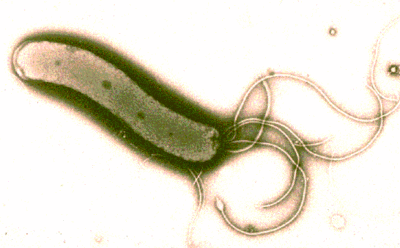Analyzing
the global genome, or the metagenome of the intestinal microbiota, has been
advanced through a new approach. This method simplifies microbiome analysis. Through
this scientists have been able to sequence and assemble the complete genome of
238 intestinal bacteria, 75% of which were previously unknown.
 It
is estimated that 100,000 billion bacteria populate the gut of each individual
(or 10 to 100 times more than the number of cells in the human body), and their
diversity is considerable, estimated to around a thousand different bacterial
species in the intestinal human metagenome. These bacteria have become major
factors in understanding certain diseases such as obesity, type 2 diabetes, or
Crohn's disease.
It
is estimated that 100,000 billion bacteria populate the gut of each individual
(or 10 to 100 times more than the number of cells in the human body), and their
diversity is considerable, estimated to around a thousand different bacterial
species in the intestinal human metagenome. These bacteria have become major
factors in understanding certain diseases such as obesity, type 2 diabetes, or
Crohn's disease.

Researchers
from INRA, together with teams from CEA (Genoscope), CNRS and Université d'Evry
in France, and scientists from other countries, have developed a new method
that can markedly facilitate analysis of the gut metagenome, while at the same
time improving the quality of the data obtained. To achieve this, they based
themselves on a simple hypothesis:
•Within
a bacterial species harboured by the gut of an individual, the abundance of
genes remains constant, since every bacterium of a same species have the same
genes
•However,
the relative abundance of these different species can vary markedly between
individuals, from 10-fold to 1000-fold, so that of course the abundance of
genes harboured by an individual varies to the same extent.
•By
measuring the abundance of bacterial genes in different individuals, it would
therefore be possible to group the genes of a specific bacterial species,
because their abundance is the same in a particular individual but differs
between individuals.
An
analysis of 396 stool samples from Danish and Spanish individuals allowed the
researchers to cluster these millions of genes into 7381 co-abundance groups of
genes. Approximately 10% of these groups (741) corresponded to bacterial
species referred to as metagenomic species (MGS); the others corresponded to
bacterial viruses (848 bacteriophages were discovered), plasmids (circular,
bacterial DNA fragments) or genes which protected bacteria from viral attack
(known as CRISPR sequences). 85% of these MGS constituted unknown bacteria
species (or ~630 species).
Using
this new approach, the researchers succeeded in reconstituting the complete
genome of 238 of these unknown species, without prior culture of these
bacteria. Living without oxygen, in an environment that is difficult to
characterise and reproduce, most of these gut bacteria cannot be cultured in
the laboratory. And until now, analysis of the metagenome was based on
comparing the genes detected in a sample with those listed in catalogues of
genes from bacteria that were known and could be cultivated in a laboratory (or
15% of gut bacteria), so that it was impossible to assign genes to
non-cultivable bacteria.
The
authors also demonstrated more than 800 dependent relationships within the 7381
gene co-abundance groups; this was the case, for example, of phages which
require the presence of a bacterium to survive. These dependent relationships
thus enable a clearer understanding of the survival mechanisms of a
micro-organism in its ecosystem. It is also the first time that an analysis has
clarified the relationships between different biological entities in the gut
microbiota, which will facilitate their detection, isolation and culture.
This
study throws a detailed light on microbial communities in humans. The method
thus developed enables considerably simpler analysis of genes in the gut
microbiota; it is now possible to study just a few thousand genetic elements,
or hundreds of species, rather than the millions of genes that make up the
metagenome. The method also markedly improves the reliability and accuracy of
statistical analyses.
The
research findings have been published in Nature Biotechnology. The reference
is:
H Bjørn Nielsen, S Dusko Ehrlich et al. Identification
and assembly of genomes and genetic elements in complex metagenomic samples
without using reference genomes. Nature Biotechnology, 2014;
DOI: 10.1038/nbt.2939
Posted by Tim Sandle






